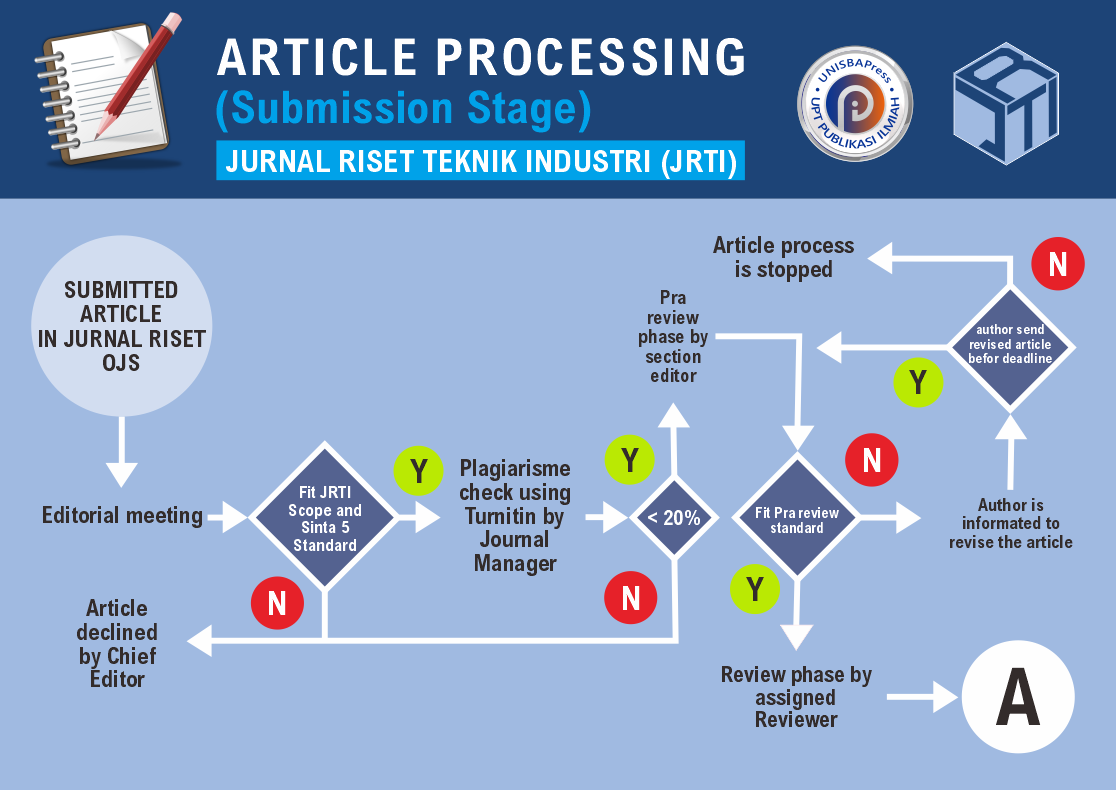Usulan Perbaikan Lintasan Produksi untuk Mereduksi Waste pada Departemen Kerja Produksi dengan Kombinasi Lean Manufacturing dan Theory of Constraints
DOI:
https://doi.org/10.29313/jrti.v1i1.233Keywords:
Lean Manufacturing, Theory of Constraints (TOC), Drum Buffer Rope (DBR), ConWIPAbstract
Abstract. CV.Bagus Jaya Textile (BJT) is an industry that produces fabrics with high value. The problem faced by CV.BJT is the imbalance of production flow that results in unmet production targets, so that the throughput obtained is not maximum. The imbalance of production flow occurs because the allocated capacity is not managed and scheduled properly, which is causing Work in Process (WIP) and waiting waste. Basically, CV.BJT has set the standard of WIP which is 30% of the overall WIP. However, in fact, WIP buildup was found by 33,33% at Stenter workstation. The causative factor is capacity constraints. Therefore, improvement efforts are needed to overcome the problems faced by CV.BJT. This research aims to reduce waste also manage and schedule constraint workstations. Improvement efforts are made by implementing a combination of Lean Manufacturing and Theory of Constraints. The improvements can reduce waiting time from 406,51 to 182,65 minutes /batch. This is due to the implementation of conWIP system that makes WIP decreased by 31,25% from the initial condition. While the constraints workstation is managed and scheduled by Drum Buffer Rope method, so that the capacity of future conditions can meet production targets. When the production target is met, the throughput increases from Rp 9.255.067.125 to Rp 10.297.640.532. The impact of improvement efforts can reduce production lead time from 2.229,48 to 2.005,62 minutes /batch.
Abstrak. CV.Bagus Jaya Textile (BJT) merupakan industri yang menghasilkan kain dengan value tinggi. Permasalahan yang dihadapi oleh CV.BJT yaitu ketidakseimbangan aliran produksi yang mengakibatkan target produksi tidak terpenuhi, sehingga throughput yang diperoleh tidak maksimum. Ketidakseimbangan aliran produksi terjadi karena kapasitas yang dialokasikan tidak dikelola dan dijadwalkan dengan baik, sehingga menimbulkan Work in Process (WIP) dan waiting waste. Pada dasarnya, CV.BJT sudah menetapkan standar adanya WIP yakni sebesar 30% dari WIP keseluruhan. Namun, kenyataanya masih ditemukan penumpukan WIP sebesar 33,33% di stasiun kerja Stenter. Faktor penyebabnya yaitu capacity constraints. Oleh karena itu, perlu adanya upaya perbaikan untuk mengatasi permasalahan yang dihadapi oleh CV.BJT. Penelitian ini bertujuan untuk mereduksi waste dan mengelola serta menjadwalkan stasiun kerja constraints. Upaya perbaikan dilakukan dengan menerapkan kombinasi Lean Manufacturing dan Theory of Constraints. Perbaikan tersebut dapat mereduksi waktu tunggu dari 406,51 menjadi 182,65 menit/batch. Hal tersebut karena adanya pemberlakuan sistem ConWIP yang membuat WIP menurun sebesar 31,25% dari kondisi awal. Sementara stasiun kerja constraints dikelola dan dijadwalkan dengan metode Drum Buffer Rope, sehingga kapasitas kondisi future dapat memenuhi target produksi. Ketika target produksi terpenuhi, maka throughput meningkat dari Rp. 9.255.067.125 menjadi Rp. 10.297.640.532. Dampak dari upaya perbaikan dapat mereduksi production lead time dari 2.229,48 menjadi 2.005,62 menit/batch.












